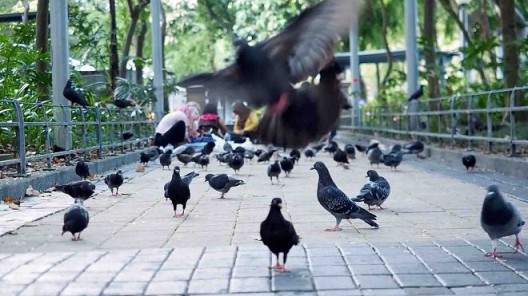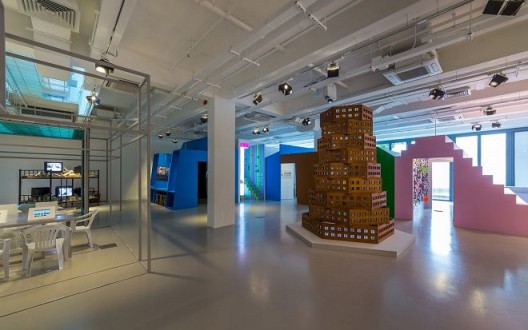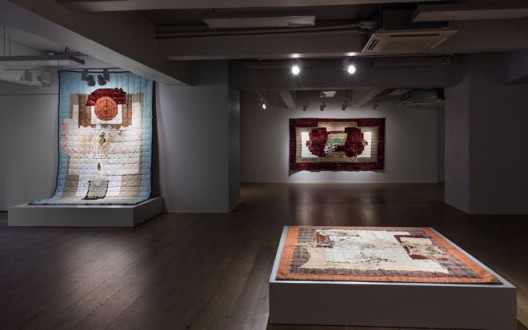“Talkover/Handover 2.0″, 1a space (Unit 14, Cattle Depot Artist Village, 63 Ma Tau Kok Road, To Kwa Wan, Kowloon, Hong Kong), Jun 29–Jul 31, 2017
A follow up to its first iteration, “Talkover/Handover”, in 2007, the space’s latest show is a quiet but nevertheless thoughtful reflection on identity, national sovereignty, and borders.
Yim Sui Fong’s trio of videos cleverly adopts the pigeon as narrator and metaphor to examine issues relating to new immigrants and social despair. Particularly poignant is “Fall like a Feather”, which asks its participants to mimic the movement of birds, walking and fluttering about, comically collapsing in slow motion, all against the backdrop of the Victoria Harbour, among other places. While the act of falling conveys a general sense of helplessness, it also dredges up a raft of visual imagery—of Margaret Thatcher’s slip at the steps of the Great Hall of the People in Beijing in 1982 during negotiations on the future of Hong Kong, but also of SARS, the disease that first emerged in southern China, but struck Hong Kong hard, killing (“felling”) hundreds in 2013.
Given the emphasis on the use of WeChat and TaoBao, and cross-border collaborations, it’s easy to read Law Yuk Mui’s “Project 123” and “It Is Raining, What Time Is It” as metaphors for the blurring of the divide between Hong Kong and Mainland Chinese identities. Yet, the tenderness that threads through the exhibits on displays, including the two pairs of sneakers worn by the artist and her Beijing friend, also resists simple conclusions.
One can imagine Tsang Tak Ping approaching his art like a Japanese “ikebana” artist would, or like an artist of irreverent assemblages. In one, a voluptuous “flower” bouquet is in fact a bunch of unused menstrual pads, knitted together by bobby pins; in another, a lump of soil is dumped into a glass box. Wiry sprigs of dried flowers adorned the carriers. Acting as carriers of Tsang’s reflections in the last 20 years, this rare presentation by the artist is very much a reflection of the HK psyche—as a small dot on the world map, as a bustling financial capital that has seen the British, Chinese, and Japanese flex their military and political muscles, a place forever absorbing, forever transforming.

严瑞芳,《黑鸟岛》,录像,6’30”,有声,彩色

严瑞芳,《黑鸟岛》,录像,6’30”,有声,彩色

严瑞芳,《坠落如羽》,行动表演于香港多处地区演出,录像纪录11’15”,有声彩色

曾德平,《起心动念六境:烦恼自寻,我见尤烈》

曾德平,《起心动念六境:烦恼自寻,我见尤烈》

罗玉梅,《下雨了,你那边几点?》

罗玉梅,《下雨了,你那边几点?》
“Canton Express: Art of the Pearl River Delta”, M+ Pavilion (West Kowloon Cultural District), June 23–Sep 10, 2017
Given President Xi’s visit to Hong Kong (his itinerary included the West Kowloon Cultural District), it is perhaps unsurprising that M+ has decided to anchor its recent exhibition in the Pearl River Delta rather than just Hong Kong on the 20th anniversary of the 1997 handover. As much as some would like to profess otherwise, art is political. As a re-staging of a part of Hou Hanru’s “Z.O.U. Zone of Urgency” at the 2003 Venice Biennale, the exhibition lays bare the issues the artists of the Pearl River Delta were concerned with back in 2003, but also asks the question: how many of these remain relevant today?
Among the 37 works on display was Chen Shaoxiong’s “Anti-Terrorism”. The wry videos depict the moment when airplanes are about to crash into Shanghai’s Oriental Pearl Tower and Guangzhou’s Citic Tower. It’s an obvious nod to 9-11, except in this case, China is preposterously impervious to such assaults, with the airplanes either vanishing into mid-air as soon as their tips touch the tower, or, as in a sci-fi–inspired move, the top of Citic Tower comically swerving to duck the moving plane altogether.
Infrastructure was a buzz word in the region back in 2003, and Lin Yilin highlights its perils with his distinct humor in the classic six-video “Hotbed”. In one, he moves a brick wall, brick by brick, across one of Guangzhou’s busiest streets, and in another the artist, in full swim gear, is sandwiched between two massive blocks of bricks, his hands waving about as he struggles—in vain—to break free. Fast forward 15 years, signs of urban encroachment have all but disappear, with Guangzhou having completed its transformation from a gritty industrial town to slick boom town.
Visually rich, Liang Juhui’s “City” succinctly captures every city’s struggle. Photographs depicting the backs of individuals are juxtaposed with a digital pool swirling pool of people and buildings that appears to be sucked into the bottom of a gigantic structure (the “city”), making one wonder how much space for the individual is left in a dense urban environment under the sign of “development”. It’s still a germane question.

“广东快车”,展览现场,2017(图片由香港M+博物馆提供)

梁巨辉,《城》,曲木、透明胶片、单频道录像(彩色,有声) 。香港M+博物馆藏品, 管艺捐赠, 2013年(图片由香港M+博物馆提供)

陈劭雄,《花样反恐》,木雕国际象棋、家具、双频道录像(彩色,有声)。香港M+博物馆藏品, 管艺捐赠, 2013年(图片由香港M+博物馆提供)

林一林,《温床》,钢架双层床、砖、六频道视像(彩色,有声) 。香港M+博物馆藏品, 管艺捐赠, 2013年(图片由香港M+博物馆提供)

徐坦,《双年展‧狗》,数码帆布横额。香港M+博物馆藏品, 管艺捐赠, 2013年(图片由香港M+博物馆提供)
Fereydoun Ave, “Shah Abbas and His Page Boy”, Rossi & Rossi (3C Yally Industrial Building, 6 Yip Fat Street, Wong Chuk Hang), May 27–Jul 29, 2017
Long regarded as Persia’s most competent ruler, Abbas I was also one of its brutal. This divisiveness serves as subject for Fereydoun Ave’s latest solo at Rossi & Rossi. The exhibition title refers to a 17th-century painting of the Shah being offered wine by a young cup bearer. It is a tender moment, and one that contradicts deeply with narratives of the Shah as a cruel despot who reportedly murdered one son and blinded two other.
In a way, “Shah Abbas and his Page Boy” is a continuation of Ave’s Rotsam series, where he explores the masculine ideal in traditional Iranian society. Whereas Rotsam placed the “ideal” male hero against a backdrop of big birds and spray paint, here kitschy magazine cut-outs of male wrestlers are plastered atop quilts fashioned from fabrics sourced from Tehran’s bazaar. Rid of their original context, the wrestlers, in various “macho” poses, appear emasculated, becoming a mere side note against the rich textures of the quilt. The faces and bodies of these wrestlers are further obscured by the splatters of red and white paint—a nod also to Cy Twombly, with whom the artist once shared a studio. Here, the “lahaf”, or padded quilt, takes on dual meaning: as much as it warms and comforts, it also covers up and suppresses.
Amid the contradicting narratives, Ave brings to light the discrepancies of modern Iran: much like the Shah whose benevolent public image belies a more violent streak, the Iranian masculine ideal has long given way to a more estranged narrative.

Fereydoun Ave,“沙阿·阿巴斯和他的男仆”,展览现场,Rossi & Rossi,2017(图片由Rossi & Rossi提供)

Fereydoun Ave,“沙阿·阿巴斯和他的男仆”,展览现场,Rossi & Rossi,2017(图片由Rossi & Rossi提供)

Fereydoun Ave,《Lahaf 19》,183 cm x 320 cm(图片由Rossi & Rossi提供)

Fereydoun Ave,《Rostam》(图片由Rossi & Rossi提供)
Wong Chung-Yu, “Centrifugal Force”, Hanart TZ gallery (401 Pedder Building, 12 Pedder Street, Central, Hong Kong), Jun 10–Jul 15, 2017
Computer technology and a dystopian view coalesce in a series of unsettling paintings and animations at Wong Chung Yu’s first solo in Hanart TZ gallery. The artist is perhaps best known for his animations that deftly combines tongue-in-cheek narrative style and back-to-basics illustration with philosophical underpinnings. Many have seen the artist’s “The Garden of Eden” when it was first exhibited as part of “Ink Art vs. Ink Art” at the Hong Kong Museum of Art. For “Centrifugal Force”, the artist adds three more videos—“Sodom”, “reBond” and “Carnivore”—to the mix. While “Sodom”, with its uncompromising depiction of sex, is likely to attract the most eyeballs, Carnivore plays well to our current fascination with—and fear of—robotic intelligence, where skeletal keys take the place of heads, and the figures plug them into powered outlets to recharge. In the other room, “A Transiting Cycle of Dualism” is more serious, but also less successful, the combination of wood, paper and digital hand scroll proffering a clichéd commentary on the cyclical nature of life, transformation, and death.
The exhibition also marks Wong’s foray into Chinese ink painting. While appearing like classical landscapes from afar, the artist’s compositions are disrupted by sci-fi bunkers, their formalist design juxtaposing with—as the curator Valerie C. Doran notes in her essay—the biomorphic form of the natural elements. Any signs of human life is long gone, and all the world is left with is rolling waters, mist-obscured mountains and the moment when the sun rises over the sea, creating a burst of colorful clouds, perhaps not unlike what we imagine the origin of life to be. That, to me, was a much more vigorous comment on the cyclical nature of life.

WONG Chung-yu, “Carnivore”, real-time random animation, 2015 (image courtesy of the artist and Hanart TZ Gallery)
黄琮瑜,《肉食者》,动画,2015(图片由艺术家及汉雅轩提供)

黄琮瑜《相生阵》,装置艺术:水墨纸本、粉彩、木制品、互动数码媒体,250 x 700 x 700 cm,2013(图片由艺术家及汉雅轩提供)

黄琮瑜《相生阵》,装置艺术:水墨纸本、粉彩、木制品、互动数码媒体,250 x 700 x 700 cm,2013(图片由艺术家及汉雅轩提供)

黄琮瑜,《幻景图5》,水墨 设色 绢本,双联屏 : 183 x 183 cm,2015(图片由艺术家及汉雅轩提供)

黄琮瑜,“离心力:黄琮瑜的艺术力场”,展览现场,汉雅轩,2017(图片由汉雅轩提供; 摄影:Kitmin Lee)

黄琮瑜,“离心力:黄琮瑜的艺术力场”,展览现场,汉雅轩,2017(图片由汉雅轩提供; 摄影:Kitmin Lee)
Jacqueline Kiyomi Gordon, “Catchy”, Empty Gallery (19/F, Grand Marine Center, 3 Yue Fung St, Tin Wan, Hong Kong), Jun 17–Aug 19, 2017
Having taken on the US military’s use of Long Range Acoustic Device (LRAD) in her previous exhibition, Jacqueline Kiyomi Gordon has picked a decidedly more lighthearted subject matter for her Hong Kong show: the pop music industry. Or so you would think.
Given how the global entertainment industry is a grand manipulator of taste, Gordon demonstrates how devices not fundamentally unlike LRAD or anechoic chambers can be used to manipulate one’s experience of sounds and sound waves. The disorienting experience begins on entering Empty Gallery’s pitch-dark space. Gordon has partnered with a group of music professionals to conjure “Catchy”, a pop song that is being diffused through the multi-channel speakers littered throughout the gallery. Several sound-absorbing structures form an irregular pattern on the wall, while your sonic experience is further disrupted by the pneumatic structure that appears like somebody’s slick guest lounger when deflated, and a menacing maze you can’t wait to get out off when pumped full with air. On the lower floor, a few more of those padded quilts take center stage, their colorful hues being an apt sonic personification of the song whose catchy beats will stay in your head long after you’ve left the gallery. You stumble out of the dark and into the daylight, feeling a little wiser about how easy the human senses can be manipulated, until you realize that you’re still defenseless against it.

Jacqueline Kiyomi Gordon,《噪音毯子,No. 10》,2017(图片由Empty Gallery 提供)

Jacqueline Kiyomi Gordon,《不全是降B调》,2017(图片由Empty Gallery 提供)

Jacqueline Kiyomi Gordon,《不全是降B调》,2017(图片由Empty Gallery 提供)


Jacqueline Kiyomi Gordon,《噪音毯子,No. 5》,2017(图片由Empty Gallery 提供)
R. Streitmatter-Tran, “Departures: Intersecting Vietnamese Modern Art with R. Streitmatter-Tran”, de Sarthe gallery (20/F, Global Trade Square, No. 21 Wong Chuk Hang Road, Hong Kong), May 26–Jul 8, 2017
As Hong Kong (still) struggles to come to terms with its own identity, Vietnam is facing colonial and historic demons of its own. De Sarthe’s latest show offers such a glimpse, with the American-born, Vietnam-based artist Richard Streitmatter-Tran enlisted to “respond” to traditional Vietnamese art. The artist refashions the city center of Hanoi with four megaphone-equipped beams; one is toppled over and lies destitute on the floor. Rather than blast propaganda messages, however, the megaphones play a soothing tune by Vietnamese musician Nhung Nguyen. Does it symbolize hope for an alternative Vietnam, or is an elegy for a dying one?
The artist’s proclivity for theatrics is also seen in “Vital Matter” (2017). Three unfired clay sculptures are placed within separate vitrines. Equipped with sprinklers, water is sprayed every ten-minute interval, moistening and disfiguring the sculpture. The idea of the melting sculpture isn’t new, but it takes on new meaning when contrasted with the traditional paintings depicting demure Vietnamese women, fish heads, and so forth, on the wall behind, calling into question the stability of beauty, as well as Vietnamese traditions.
There are also misses. Fashioned from acrylic cut-outs, “Our Lady of La Vang” (2017) recalls the Marion apparition of 1798, where the Virgin Mary is said to have made an appearance against a backdrop of intense Catholic persecution in Vietnam. It also appears to pay tribute to Matisse, but the connection between the former and latter is unclear. Or “The Gates of Hell”, erected in French Deco-style with the words “Ecole Superieure des Beaux Art” and “Indo Chine” at the bottom, and “Cong Dia Nguc” (“The Gates of Hell” in Vietnamese) at the top, highlights the double-edged sword of colonialism: while it has given Vietnam such schools as the Ecole, it has also left behind a muddy trail of colonial legacy that remains unresolved to this day. While very Instagram-worthy, the didactic message leaves little to the imagination.
The apogee for me was an unassuming quartet of silk paintings entitled “Configurations in Black (After Nguyen Phan Chanh)”. Nguyen, the silk artist known for his technical dexterity as well as his portrayals of rural living. Rid of any theatrics or moral messages, the piece follows in the tradition of painting the everyday, but by panning in onto the flash of a leg, an arm and nape, Streitmatter-Tran also makes it his own, giving a glimpse of where he wants to take Vietnamese figurative paintings.

R. Streitmatter-Tran , “Departures: Intersecting Modern Vietnamese Art with R. Streitmatter-Tran”, de Sarthe Gallery, Hong Kong, 2017 (courtesy of de Sarthe Gallery)
陈德良,“离境:陈德良与越南现代艺术的交织”,展览现场,德萨画廊,香港,2017(图片由德萨画廊提供)

陈德良,“离境:陈德良与越南现代艺术的交织”,展览现场,德萨画廊,香港,2017(图片由德萨画廊提供)

R. Streitmatter-Tran , “Departures: Intersecting Modern Vietnamese Art with R. Streitmatter-Tran”, de Sarthe Gallery, Hong Kong, 2017 (courtesy of de Sarthe Gallery)
陈德良,“离境:陈德良与越南现代艺术的交织”,展览现场,德萨画廊,香港,2017(图片由德萨画廊提供)

陈德良,“离境:陈德良与越南现代艺术的交织”,展览现场,德萨画廊,香港,2017(图片由德萨画廊提供

R. Streitmatter-Tran , “Departures: Intersecting Modern Vietnamese Art with R. Streitmatter-Tran”, de Sarthe Gallery, Hong Kong, 2017 (courtesy of de Sarthe Gallery)
陈德良,“离境:陈德良与越南现代艺术的交织”,展览现场,德萨画廊,香港,2017(图片由德萨画廊提供)